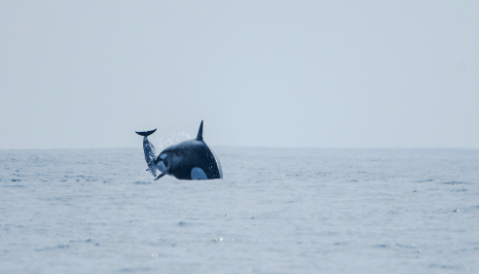
While hunting, an orca (identified as pod matriarch Dakota) propels a dusky dolphin into the air. Image by Maikol Barrera.
Scientists have managed to track a mysterious population of orcas living off the coast of Chile and learn more about them, starting with their food supply. Orcas divide into different ecotypes based on their hunting specialisms: new data suggests that the Chilean orcas are incredibly skilled mammal-hunters, chasing down dusky dolphins and sharing the food amongst themselves. This could mean they belong to the Type A ecotype — a potentially important piece of the puzzle for understanding and conserving orca populations in the southern hemisphere.
Off the coast of Chile, in waters filled with krill and anchovy by the Humboldt Current system, live an elusive and little-known population of orcas. Thanks to citizen science and years of dedicated surveillance, a team of scientists led by Dr Ana García Cegarra of the Universidad de Antofagasta are unveiling their secrets — starting with dinner.
García Cegarra’s team, who previously observed these orcas using fishing boats to help them capture sea lions, have now spotted them successfully hunting dusky dolphins for the first time and sharing the food among the pod. This new evidence about their eating habits may help experts understand how populations of orcas in the southern hemisphere are linked, promoting conservation efforts.
“Studying orcas in their natural environment is very challenging as they are marine top predators, travelling long distances and living offshore, which makes observation difficult,” said García Cegarra, lead author of the study in Frontiers in Marine Science. “But understanding their role in the marine environment is crucial for the conservation of this poorly-known species in the Humboldt Current.”
You are what you eat
Orcas are apex predators with an impressively varied diet — but not all orcas eat the same things. Populations can be assigned to different ecotypes based on their preferred foods, acoustics, and genetics, so understanding what the orcas of the Humboldt Current eat is a major step towards understanding where they fit in among the other orcas of the world. Five different ecotypes are reported in the southern hemisphere: some, like Type A and Type B1 orcas, focus on marine mammals, while other types prefer fish. Understanding where the Humboldt Current animals fit in would help us understand the way these populations relate to each other more broadly and conserve them for the future.
García Cegarra and her colleagues used a combination of their own surveys and citizen science data collection from whale-watching trips and fishing vessels to monitor the population and track their hunting choices. Observers recorded the presence of orcas, group composition and location, and took pictures and videos which the scientists could cross-reference with catalogues of known individuals. By combining this data with their own systematic surveys and drone footage, the scientists built up a map of orca presence in the area and tracked pods’ behavior and prey choices.
This allowed the researchers to capture evidence of the Menacho pod of orcas catching dusky dolphins — a species no orcas in this area have ever been reported successfully hunting. Dramatic images show the matriarch, Dakota, tossing a dusky dolphin into the air.
These sightings could indicate that these orcas may belong to the mammal-hunting Type A ecotype. Their prey, and their small pod sizes, would be consistent with this hypothesis, although their white eye patches are smaller than is typical of Type A orcas. They have also never been recorded in Patagonia with other Type A orcas.
“We wish we could obtain skin biopsy samples to analyze their genetic data, as there is no genetic information for orcas in this region of the south-east Pacific,” said García Cegarra. “However, they are very elusive and intelligent, which makes it difficult to approach them in the boat for biopsies.”
Sharing the spoils
The scientists’ observations of the dusky dolphin hunting also revealed that the Menacho pod were sharing their food. Food sharing is recorded among many populations of orcas, sometimes to help feed kin, and sometimes because the pod hunts cooperatively and everyone gets a share. In this case, García Cegarra and her colleagues suggest that the Menacho pod were sharing food with kin, similar to Type A orcas who hunt sea lions by deliberately stranding: female orcas were seen sharing meat with group members, allowing closer relations to eat first.
García Cegarra emphasized that much more information and systematic study is necessary to fully understand and protect this secretive population of orcas. “The fact that we have observed newborn calves is important, because it indicates that they are having offspring, but we don’t know their survival rate,” she said. “Thanks to citizen science, we can follow the presence of killer whales along thousands of kilometers of the coast of northern Chile — but most orca sightings are opportunistic.”